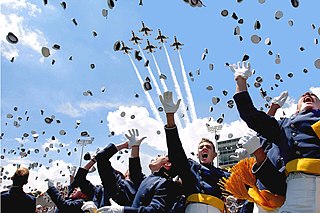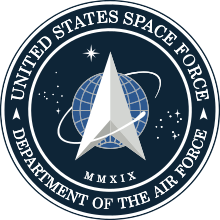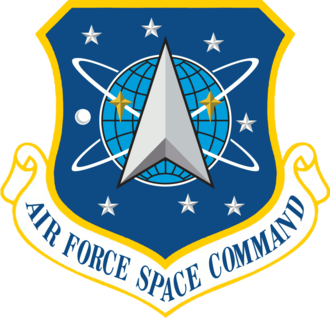
Air Force Space Command (AFSPC) was the major space command of the United States Air Force and the de facto space force of the United States Armed Forces from 1982 to 2016. Air Force Space Command was created on 1 September 1982 to unify the Air Force's space forces, which were organized under Air Force Systems Command, Aerospace Defense Command, and Strategic Air Command and is the direct predecessor to the United States Space Force, one of the six military services in the United States Armed Forces. Air Force Space Command was the first military space command in the U.S. Air Force, providing space forces for the 1983 United States invasion of Grenada, 1986 United States bombing of Libya, and 1989 United States invasion of Panama. The first major employment of space forces culminated in the Gulf War, where they proved so critical to the U.S.-led coalition, that it is sometimes referred to as the first space war.

The National Aeronautics and Space Administration (NASA) logo has three main official designs, although the one with stylized red curved text was retired from official use from May 22, 1992, until April 3, 2020, when it was reinstated as a secondary logo. The three logos include the NASA insignia, the NASA logotype, and the NASA seal.

The 2d Space Wing was a wing of the United States Air Force. Constituted on 5 December 1984 and activated on 8 July 1985, it was the host wing at Falcon Air Force Station. It took operational control of the Air Force Satellite Control Network in October 1987. It was inactivated on 30 January 1992 when the 50th Space Wing replaced it.

United Launch Alliance (ULA) is an American spacecraft launch service provider that manufactures and operates a number of rocket vehicles that are capable of launching spacecraft into orbits around Earth and to other bodies in the solar system. The company, which is a joint venture between Lockheed Martin Space and Boeing Defense, Space & Security, was formed in December 2006. Launch customers of the United States government include the Department of Defense (DoD), NASA, and other organizations.

The Eagle, Globe, and Anchor, is the official emblem and insignia of the United States Marine Corps. The current emblem traces its roots in the designs and ornaments of the early Continental Marines as well as the United Kingdom's Royal Marines. The present emblem, adopted in 1955, differs from the emblem of 1868 only by a change in the eagle. Before that time many devices, ornaments, ribbons, and distinguishing marks followed one another as official badges of the corps.

The 50th Space Communications Squadron is a squadron of the United States Space Force located at Schriever Air Force Base, Colorado. The squadron provides command and control systems, configuration control, and systems integrations for seven Department of Defense space programs including $8.2 billion Space Force Satellite Control Network supporting $50 billion in national satellite and terrestrial systems for United States, allied, and coalition forces.

The 45th Space Wing is a United States Space Force space launch wing. The 45th Space Wing is assigned to Space Operations Command and headquartered at Patrick Space Force Base, Florida. The wing also controls Cape Canaveral Space Force Station. The 45th Space Wing is responsible for all space launch operations from the East Coast. It manages the Eastern Range, including launch activities for the Space Force, Department of Defense, NASA, and other private space corporations.

The United States Space Force's 1st Space Operations Squadron is a space operations unit located at Schriever Air Force Base, Colorado. The squadron is responsible for performance launch, on-orbit, emergency, end-of-life testing and disposal operations providing warning, navigation, R&D, surveillance and weather to the president and the Secretary of Defense, Joint Chiefs of Staff and nine combatant commanders worldwide.

The United States Air Force's 3d Command and Control Squadron was a command and control unit located at Offutt AFB, Nebraska.

The 3d Space Support Wing was a wing of the United States Air Force active from 1986 to 1992 at Peterson Air Force Base, Colorado as part of Air Force Space Command.

The 1st Space Wing was a wing of the United States Air Force active from 1983 to 1992 at Peterson Air Force Base, Colorado as part of Air Force Space Command.

The United States Air Force Academy Cadet Wing (AFCW) is the student body of the United States Air Force Academy. The students, called "cadets", are divided into four classes, based on their year in school, much like a civilian college. They are not referred to as freshmen, sophomores, juniors and seniors, however, but as fourth-, third-, second- and first class cadets, respectively. Fourth class cadets (freshmen) are sometimes referred to as "doolies," a term derived from the Greek word δοῦλος ("doulos") meaning "slave" or "servant." Members of the three lower classes are also referred to as "4 degrees," "3 degrees" or "2 degrees" based on their class. First-class cadets (seniors) are referred to as "firsties." In the military structure of the Cadet Wing, first class cadets hold the positions of cadet officers, second class cadets act as the cadet non-commissioned officers and third class cadets represent the cadet junior non-commissioned officers. The wing is commanded by the Cadet Wing Commander (AFCW/CC), the highest ranking, first-class cadet.

The United States Space Force (USSF) is the space service branch of the U.S. Armed Forces, one of the eight U.S. uniformed services, and the world's first and currently only independent space force. The U.S. Space Force is a military service branch, and along with sister-branch, the U.S. Air Force, is part of the Department of the Air Force, one of the three civilian-led military departments within the Department of Defense. The Space Force, through the Department of the Air Force, is overseen by the Secretary of the Air Force, a civilian political appointee who reports to the secretary of defense, and is appointed by the president with Senate confirmation. The military head of the Space Force is the chief of space operations who is the most senior Space Force officer, unless a Space Force officer is serving as either the chairman or vice chairman of the Joint Chiefs of Staff. The chief of space operations exercises supervision over the Space Force's units and serves as one of the Joint Chiefs of Staff.
The Space Operations Badge is an occupational badge for guardians of the United States Space Force and space airmen of the United States Air Force while the United States Army (USA) version of the badge, known as the Space Badge, is a special skills badge for soldiers who qualify as space professionals.

Badges of the United States Space Force are specific uniform paraphernalia authorized by the United States Space Force that signify ratings, special skills, career field qualifications, and serve as identification devices for personnel occupying certain assignments. Space Force occupational badges are awarded in three degrees or skill levels. Badges for space operations are awarded at basic, senior, and command levels; other occupational badges are issued in basic, senior, and master level. A star and wreath system, worn above the badge, denotes which degree or skill level a service member currently holds.
United States Space Force rank insignia are used to indicate the rank and status of its officers and enlisted personnel. Equivalency between the military services is indicated by associated NATO code and pay grade.

The Chief Master Sergeant of the Space Force is the senior enlisted advisor to the chief of space operations and the secretary of the Air Force. The Chief Master Sergeant of the Space Force is the highest-ranking non-commissioned officer in the Space Force, unless the senior enlisted advisor to the chairman is a Space Force enlisted guardian.

The flag of the United States Space Force is the flag used to represent the United States Space Force, as well as its subsidiary units and formations. It was officially unveiled on 15 May 2020.

The Space Force Delta is the official logo of the U.S. Space Force, the space warfare service branch of the U.S. Armed Forces. The delta itself was unveiled on 22 July 2020.
Comparison of ranks and insignia of all current and former space forces, to include aerospace forces and air and space forces.



















